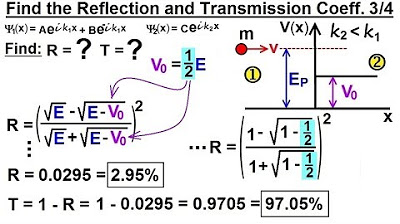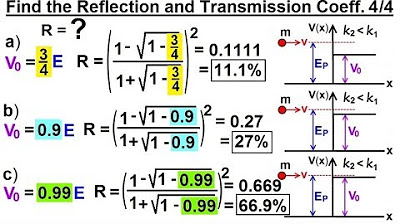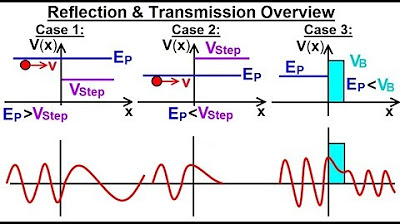Physics - Ch 66 Ch 4 Quantum Mechanics: Schrodinger Eqn (71 of 92) R=? T=? V0=(1/4)E (Ex. 1 of 4)
TLDRThis lecture explores the quantum behavior of particles encountering a potential step, where even a potential energy equal to a quarter of a particle's energy results in a surprisingly low reflection coefficient of 0.52%. The transmission coefficient is found to be 99.48%. The discussion delves into the mathematical derivation of these coefficients and hints at further analysis with different potential energies to understand how the percentages change.
Takeaways
- 📚 The lecture discusses the quantum mechanical reflection and transmission of particles at a potential step.
- 🌟 The potential step's energy is given as 1/4 the energy of the particle.
- 🔢 Even at a 1/4 energy potential step, only a small percentage of particles will be reflected.
- 📈 The calculation involves replacing the potential energy (V) with 1/4 of the particle's energy (E) in the equation.
- 🧮 The mathematical process simplifies to finding the square root of E minus the square root of 3/4 E over the square root of E plus the square root of 3/4 E.
- 🤔 The reflection coefficient is calculated to be 0.0052 or 0.52%, indicating a small fraction of particles will be reflected.
- 📊 The transmission coefficient is the complement of the reflection coefficient, calculated as 1 minus the reflection coefficient.
- 🌈 For the given potential step, 99.48% of the particles will be transmitted.
- 🔧 The lecture suggests exploring how the percentages change with different potential step values (1/2, 3/4, etc.)
- 💡 The example illustrates the counterintuitive nature of quantum mechanics where a significant potential step does not necessarily lead to a high reflection rate.
- 📖 The process is demonstrated step-by-step, emphasizing the importance of mathematical analysis in understanding quantum phenomena.
Q & A
What is the potential step in the given example?
-The potential step in the example is 1/4 the energy of the particle.
What was the initial assumption about the number of particles reflected and transmitted?
-The initial assumption was that if the potential step is 1/4 the energy of the particle, a fair number of particles would be reflected and a greater number transmitted.
Why does the actual percentage of reflected particles differ from the initial assumption?
-The actual percentage of reflected particles differs because the nature of the equation results in a very small percentage of particles being reflected, even when the potential step is 1/4 the energy of the particle.
How is the reflection coefficient calculated?
-The reflection coefficient is calculated by squaring the difference between the square root of the particle's energy (E) and the square root of 3/4E, and then dividing by the square of the sum of the square root of E and the square root of 3/4E.
What is the numerical value of the reflection coefficient in the example?
-The numerical value of the reflection coefficient in the example is 0.0052, or 0.52%.
What percentage of particles are transmitted when the potential step is 1/4 the energy of the particle?
-When the potential step is 1/4 the energy of the particle, 99.48% of the particles are transmitted.
How does the potential step affect the reflection and transmission coefficients?
-The potential step affects the reflection and transmission coefficients by determining the fraction of particles that will be reflected or transmitted. As the potential step increases, the reflection coefficient may increase and the transmission coefficient may decrease.
What happens to the reflection coefficient when the potential step is 1/2 the energy of the particle?
-The script does not provide specific details for when the potential step is 1/2 the energy of the particle, but it implies that the percentage of reflected particles would change, likely increasing from the 0.52% when the potential step is 1/4 the energy.
What is the significance of the square root of E in the calculation?
-The square root of E is significant as it represents the base energy level of the particle. It is used in the numerator and denominator of the reflection coefficient formula, indicating its fundamental role in determining the outcome.
How does the transmission coefficient relate to the reflection coefficient?
-The transmission coefficient is calculated as 1 minus the reflection coefficient. This means that as the reflection coefficient increases, the transmission coefficient decreases, and vice versa.
What can we infer about the relationship between the potential step and the energy of the particle?
-We can infer that even a relatively large potential step, such as 1/4 the energy of the particle, does not result in a high percentage of particles being reflected. This suggests that the energy of the particle has a more significant impact on the transmission and reflection outcomes than the size of the potential step alone.
Outlines
📚 Quantum Mechanics: Reflection and Transmission at a Potential Step
This paragraph introduces a lecture on quantum mechanics, focusing on the concept of particle reflection and transmission at a potential step. The discussion begins with an example where the potential step's energy is 1/4 of the particle's energy. It explains that despite the potential step being significant (1/4 of the particle's energy), the percentage of particles reflected is surprisingly small. The lecturer then walks through the mathematical derivation, starting with the substitution of V by 1/4 of the energy, leading to a complex equation. After simplification, the reflection coefficient is calculated to be 0.0052 or 0.52%, indicating that only a small fraction of particles will be reflected. The transmission coefficient is deduced as 99.48%, showing that the majority of particles will be transmitted. The paragraph concludes by hinting at further exploration of how the percentages change with different potential step values.
Mindmap
Keywords
💡potential step
💡reflection coefficient
💡transmission coefficient
💡energy of the particle
💡quantum mechanics
💡particle
💡mathematical equations
💡wave dynamics
💡potential energy
💡calculation
💡interaction
Highlights
The potential step is 1/4 the energy of the particle.
A fair number of particles would be reflected at this energy ratio.
The actual percentage of reflected particles is very small despite the potential step being 1/4 the energy.
The equation used in the example is fundamental to understanding particle behavior.
V is replaced by 1/4 the energy to calculate the reflection coefficient.
The reflection coefficient is calculated as the square root of (E - (1/4)E) over the square root of (E + (1/4)E), squared.
The square root of E can be factored out for simplification.
The reflection coefficient simplifies to (1 - (3/4)^0.5) / (1 + (3/4)^0.5)^2.
The final result for the reflection coefficient is 0.0052 or 0.52%.
The transmission coefficient is 1 minus the reflection coefficient, which equals 0.9948 or 99.48%.
Even with a potential step of 1/4 the energy, only slightly over 1/2 of 1% of particles are reflected.
The lecture discusses how the reflection and transmission percentages change with different potential step values.
The example demonstrates the impact of potential energy on particle transmission and reflection.
The mathematical process is detailed to show how the coefficients are derived and calculated.
The lecture provides a practical application of quantum mechanics principles.
The calculation shows that a higher potential step leads to a smaller reflection coefficient.
The lecture is an example of applying theoretical physics to real-world scenarios.
The results have implications for understanding particle behavior in various energy fields.
Transcripts
Browse More Related Video

Physics - Ch 66 Ch 4 Quantum Mechanics: Schrodinger Eqn (72 of 92) R=? T=? V0=(1/4)E (Ex. 2 of 4)

Physics - Ch 66 Ch 4 Quantum Mechanics: Schrodinger Eqn (67 of 92) Finding R=? T=? Coefficients

Physics - Ch 66 Ch 4 Quantum Mechanics: Schrodinger Eqn (73 of 92) R=? T=? V0=(1/2)E (Ex. 3 of 4)

Physics - Ch 66 Ch 4 Quantum Mechanics: Schrodinger Eqn (74 of 92) R=? T=? V0=(3/4)E,.(Ex. 4 of 4)

Physics - Ch 66 Ch 4 Quantum Mechanics: Schrodinger Eqn (64 of 92) Transmission-Reflection (Q.M.)

Physics - Ch 66 Ch 4 Quantum Mechanics: Schrodinger Eqn (61 of 92) Reflection & Transmission
5.0 / 5 (0 votes)
Thanks for rating: